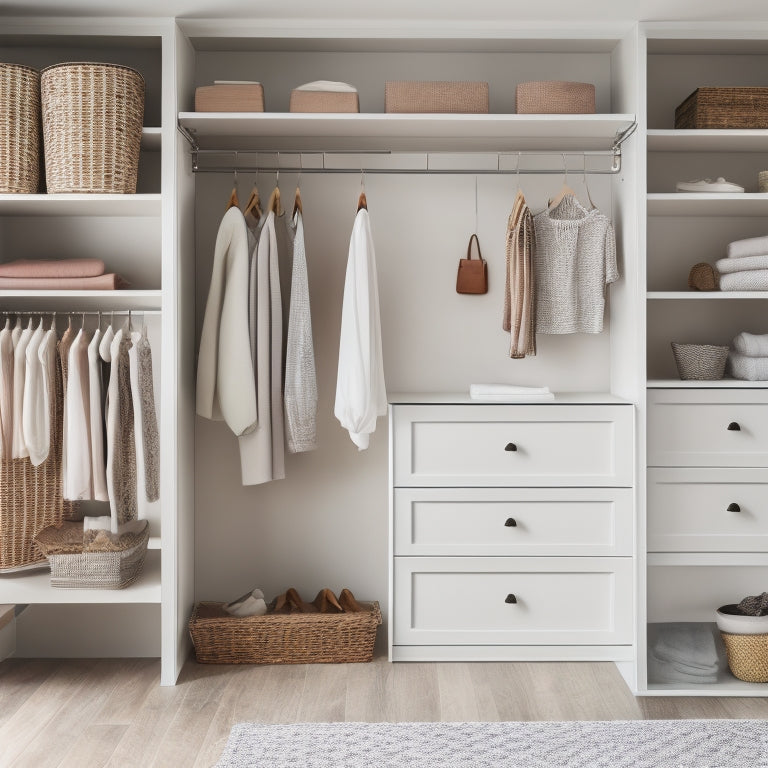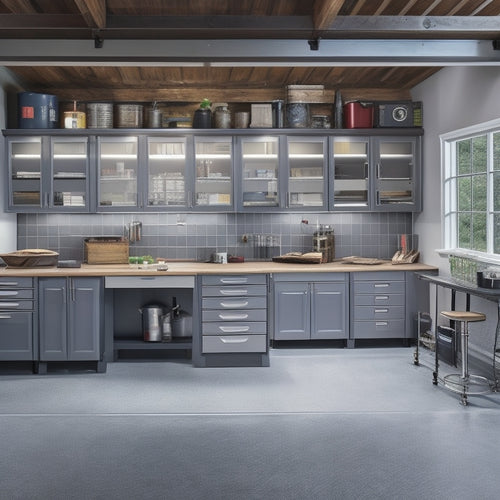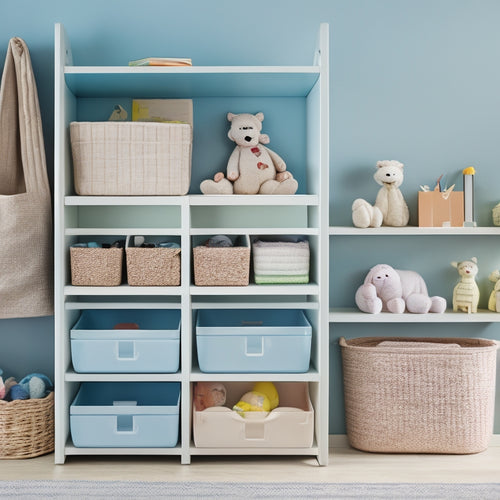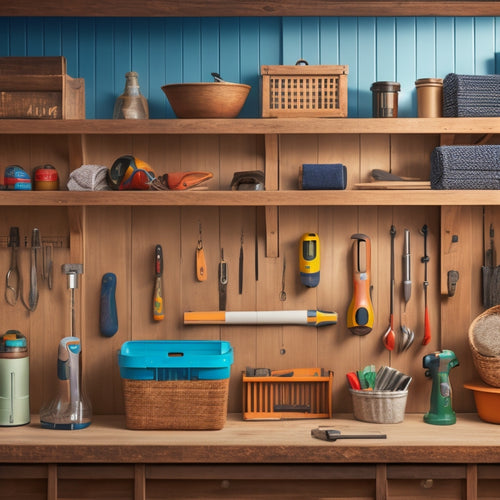
Storage Hacks for Organizing Your Closet
Share
You can revolutionize your closet space by maximizing vertical storage with wall-mounted racks, ladder shelves, and overhead bins. Employ hidden corners with shelves, carousels, or stackable baskets, and streamline your shoe collection by sorting, storing out-of-season shoes, and creating a dedicated zone. Organize accessories with jewelry boxes, hanging organizers, and designated areas for belts and scarves. Create functional zones for frequently worn items, out-of-season clothing, and accessories, and consider labeling systems for clear organization. With these hacks, you'll be on your way to a clutter-free closet - and there's even more to investigate to achieve ultimate closet nirvana.
Key Takeaways
- Maximize vertical storage space with wall-mounted racks, hanging organizers, and overhead bins to optimize closet capacity.
- Utilize hidden corners with corner shelves, carousels, and stackable baskets to store items like socks, hats, and accessories.
- Implement a functional closet zone by designating areas for frequently worn items, out-of-season clothing, and accessories for easy access.
- Streamline your shoe collection by sorting, storing out-of-season shoes in labeled bins, and creating a dedicated shoe zone.
- Organize accessories with ease using jewelry boxes, hanging organizers, and designated areas for belts, scarves, hats, and bags.
Maximize Vertical Storage Space
How much of your closet's potential is going to waste? By maximizing your closet's vertical storage space, you can access its full potential and create a more organized and functional area.
Start by installing wall-mounted racks or ladder shelves to store items like bags, accessories, or linens. Consider employing hanging organizers with pockets or shelves to hold items like clothes, scarves, or hats.
Don't forget to make use of your ceiling storage by installing overhead racks or bins to store out-of-season items or luggage.
Take advantage of over-the-door solutions like hooks, baskets, or shelves to hang belts, jackets, or bags. You can also apply curtain rods with hanging organizers or bins to store items like cleaning supplies or accessories.
For a more customizable option, try a pegboard system with hooks, bins, or baskets to store items like tools, accessories, or jewelry.
Finally, add some magnetic strips to store small metal items like keys, scissors, or hooks.
Double Your Shelf Capacity
You can greatly increase your closet's storage capacity by making the most of your shelf space.
To do this, you'll want to max out your vertical space by using stackable shelves or storage units that go all the way up to the ceiling.
Additionally, consider utilizing shelf dividers to keep items organized and prevent clutter from building up.
Max Out Vertical Space
Your closet's ceiling is a precious resource, and it's time to tap into it. By maximizing your vertical space, you can double your shelf capacity and make the most of your closet's storage potential.
To get started, consider installing overhead bins or storage containers to store out-of-season clothing, linens, or accessories. You can also add hanging racks with multiple levels to increase your closet's hanging capacity.
Here are some additional ways to max out your vertical space:
-
Install shelves or storage units that go up to the ceiling to store items like boxes, bins, or baskets.
-
Use stackable storage containers or bins to store items like sweaters, jeans, or blankets.
-
Hang curtains or dividers to create separate areas for different types of clothing or accessories.
-
Add a pegboard or hooks to hang belts, hats, or bags.
-
Invest in a storage loft or overhead shelving unit to store items like luggage or out-of-season decorations.
Utilize Shelf Dividers
By incorporating shelf dividers into your closet's storage system, you'll be able to double your shelf capacity and keep similar items organized and easily accessible. This is especially useful for items like folded clothes, bags, or accessories that tend to get jumbled together.
Choose shelf dividers made from sturdy shelf materials like wood, metal, or durable plastic to guarantee they can hold the weight of your stored items. You can opt for adjustable dividers that can be customized to fit your shelf's dimensions or fixed dividers that provide a more permanent separation.
Different divider styles cater to various organizational needs. For instance, cubby-style dividers are ideal for storing small items like socks or jewelry, while tall, vertical dividers are better suited for separating larger items like clothes or luggage.
Utilize Hidden Corners Effectively
The often-overlooked corners of your closet can be a hidden gem of storage space. These underused areas can be optimized with the right strategies.
By incorporating corner shelving, you can create additional storage for items that are hard to reach or awkwardly shaped.
Here are some ideas to get you started:
- Install corner shelves or carousels to maximize vertical space and make the most of your closet's corners.
- Use stackable baskets or bins to store items like socks, hats, or accessories.
- Hang a shoe organizer on the back of a door or wall to store bags, belts, or other accessories.
- Invest in a corner storage unit with drawers or cabinets to keep items like sweaters or jeans organized.
- Employ adhesive hooks or a pegboard to hang items like jackets, hats, or bags, keeping them off the floor and out of the way.
Streamline Your Shoe Collection
Scores of shoes can clutter your closet, making it difficult to find the perfect pair. To streamline your shoe collection, start by sorting them into three piles: keep, donate/sell, and discard. Be ruthless – if you haven't worn them in a year, it's likely time to let them go.
Next, consider shoe box solutions to store out-of-season shoes. This will free up precious closet space and prevent damage from stacking or overcrowding.
Implement a seasonal rotation to keep your closet organized and verify you're only storing shoes that are relevant to the current season. Store out-of-season shoes in labeled bins or containers to keep them dust-free and easily accessible.
This will also encourage you to reassess your shoe collection regularly, helping you maintain a curated selection that sparks joy. By streamlining your shoe collection, you'll save time getting dressed and reduce stress in the morning.
Organize Accessories With Ease
You've got your shoes in order, now it's time to tackle the rest of your accessories.
From tangled necklaces to mismatched earrings, you'll find it's much easier to get ready in the morning when you can quickly find what you need.
In this section, we'll investigate jewelry storage ideas and belt organization tips to keep your closet tidy and functional.
Jewelry Storage Ideas
Get a grip on your jewelry collection by implementing some clever storage ideas that'll keep your accessories organized and easily accessible.
You'll no longer have to dig through a tangled mess of necklaces or earrings to find the perfect piece to match your outfit.
To maximize your jewelry storage, consider the following ideas:
- Jewelry boxes with compartment trays to separate and protect your pieces
- Hanging organizers with pockets to store long necklaces and bracelets
- Drawer dividers to dedicate a section of your dresser to jewelry
- Wall mounted racks to display your favorite statement pieces
- Travel cases to keep your jewelry organized and safe on-the-go
Belt Organization Tips
Six belts scattered across your closet floor is a common sight, but it doesn't have to be. You can easily organize your belts with a few simple storage solutions.
Start by installing belt hooks on the back of your closet door or on a wall. These hooks allow you to hang your belts in a row, making it easy to grab the one you need.
You can also use belt racks, which can be mounted on a wall or placed on a shelf. These racks have individual slots for each belt, keeping them organized and preventing them from getting tangled.
Another option is to repurpose a frame or a wooden board with hooks attached. This DIY project can add a touch of style to your closet while keeping your belts organized.
Whatever method you choose, you'll be able to find the perfect belt to match your outfit in seconds, and your closet floor will be clutter-free.
Create a Functional Closet Zone
Breaking down your closet into separate zones can change how you organize your belongings and start your day.
By creating a functional closet zone, you'll be able to find what you need quickly, reduce clutter, and make the most of your space.
To create a functional closet zone, consider the following:
-
Wardrobe Station: Designate an area for your wardrobe rotation, where you can hang and store your most frequently worn items.
-
Seasonal Storage: Set aside a section for out-of-season clothing, shoes, and accessories, keeping them organized and out of the way.
-
Accessory Hub: Create a spot for your belts, scarves, hats, and bags, making it easy to grab what you need.
-
Shoe Sanctuary: Designate a zone for your shoes, keeping them organized, clean, and protected.
-
Drop Zone: Allocate a spot near the door or entrance for items that need to be dealt with, like dry cleaning or repairs.
Frequently Asked Questions
How Often Should I Clean Out My Closet to Maintain Organization?
You should clean out your closet every 3-6 months to maintain organization, creating a decluttering schedule to stay on track. This closet maintenance routine helps you stay organized, reduces stress, and prevents clutter buildup.
Can I Use Storage Bins Made of Fabric or Only Plastic?
You're drowning in a sea of clutter, but don't worry! You can use both fabric and plastic bins to stay afloat. Fabric bins are breathable and gentle on clothes, while plastic bins are durable and waterproof - choose what works best for you!
Are Closet Organizers Suitable for Renters or Only Homeowners?
You'll be relieved to know that closet organizers aren't just for homeowners; you can find temporary solutions and renter-friendly options that are easy to install and remove, ensuring your space stays organized and safe without damaging the property.
How Do I Organize Clothes That Are Out of Season?
Ah, the age-old problem of out-of-season clothes cluttering your life. You're not a hoarder, you're just a fashion enthusiast with a passion for seasonal storage! Rotate your clothing wisely, storing off-season items in labeled bins to free up space and your sanity.
Can I Use My Closet for Storage Other Than Just Clothing?
You can repurpose your closet as multi-purpose storage by incorporating closet accessories like shelves, bins, and hooks, allowing you to safely store items like luggage, seasonal decor, or out-of-use appliances, freeing up space elsewhere in your home.
Conclusion
As you stand in your newly organized closet, you can't help but notice the coincidence - it's as if the clutter was holding you back, and now that it's gone, you feel freer, more in control. You've maximized your space, doubled your capacity, and tamed the chaos. Your shoes are lined up, accessories are at your fingertips, and every item has its designated zone. You've created a sanctuary that sparks joy, and it's no coincidence - it's the result of intentional design and a sprinkle of storage genius!
Related Posts
-

Best Tool Chests for Home Garage Options
When selecting the best tool chest for your home garage, you'll want to evaluate top brands like DeWalt, Milwaukee, a...
-

Storage Bins for Shelves to Keep Clutter at Bay
You're looking for a way to keep your shelves organized and clutter-free, and storage bins are the perfect solution t...
-

What Tools Do I Need for a DIY Wall Organizer
You'll need a variety of tools to complete a DIY wall organizer project. Essential measuring tools include a tape mea...


